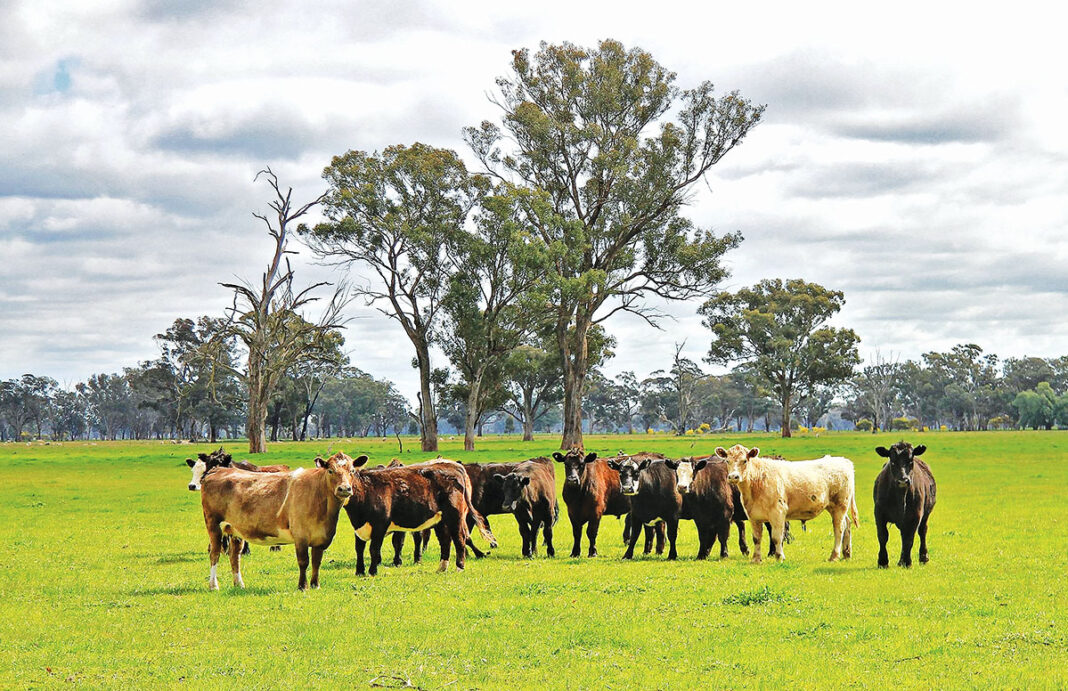Mount Gambier Cattle – October 2 Numbers rebounded this week as agents yarded 409 head of liveweight and open auction cattle These sold to a larger field of buyers with the trade, feeders and restocker orders all active over the pens.
Quality lifted with some spring finish on offer in some yards however there were some still showing the effects of the long dry period in a mixed market for price.
A small number of vealers came forward as the steers sold to 354c and the heifers to 315c/kg.
Yearling steers attracted the trade from 244c to 310c, feeders from 240c to 362c and restockers to 306c/kg.
Yearling heifers saw trade support from 260c to 355c, feeder activity from 290c to 350c and some restocker interest from 338c to 354c/kg.
Grown steers and bullocks ranged from 348c to 390c to the trade with feeders active from 368c to 380c/kg.
Grown heifers sold from 325c to 350c to the trade with some feeder interest to 342c as manufacturing steers ranged from 280c to 310c/kg.
Heavy cows lost 7c this week to sell from 272c to 323c as lighter lots sold from 200c to 280c with the trade, feeders and restockers all active.
Bulls rebounded in price by up to 30c to range from 250c to 320c/kg. Naracoorte Cattle – October 1 Numbers increased to 974 cattle to boost supply by 25% on a week ago. There were bigger lines available, particularly in the grown heifers and steer sections to suit feedlots.
The market trend was generally firm to dearer, although there was still a selective tone to bidding and there were some young cattle there were judged to be softer in places.
The positive was the return of two export orders that have been absent in recent weeks although they really did not impact results only buying limited numbers.
Not quite half the yarding was cows and the best pens showing plenty of weight and condition were firm, however the plainer mid and third run of cows were sometimes a few cents easier.
The pick of the grain fed yearlings sold to 398c/kg and the better types of young steers and heifers to the trade were generally in the range of 360c to 390c/kg.
Underneath this was a lot of sales from 310c to 370c for heifers and steers selling to a mix of processors, feedlot orders and the regular restocking interest from the south and Victoria.
Secondary animals and odd lots of a couple of head 250c to 280c/kg.
Quality improved in the grown steer section which helped support prices to a top of 393c/kg for hard finished heavy steers to processors.
Feedlots paid from 350c to 384c/kg for steers with frame and weight, while competition for feeder heifers was more robust at a top of 375c/kg to average 356c/kg over the main run.
In the cow run exporters consistently paid from 310c to 330c/kg for penlots of heavy cows in prime score 3 and 4 condition, just a few sales higher to a top of 338c/kg.
Where the market showed a little more variance was on the mid-run of cows with less fat cover and yield, prices varying from 240c to 290c/kg for most. Naracoorte Sheep – October 1 Numbers eased back again with agents advising new season lambs were being slow to reach weights this season. Agents led their sales with young unshorn lambs and there was good quality in the first few pens before weight and condition quickly dropped away.
The old season lambs were very mixed and mostly comprised smaller clean-up lots.
The best of the young trade to heavy trade lambs above 22kg cwt were dearer and there were sales well into the 800c/kg cwt price range.
However buyers were selective and any lambs which did not have hard carcass finish were sometimes overlooked by buyers, leading to an erratic market and a wide cents per kilogram price result in some categories.
One auctioneer commented the price could vary by $30 per head on young trade lambs depending on how they handled and if the main domestic buyers showed interest.
Another determining factor was number in a pen, with the bigger lines of young lambs selling better than smaller lots.
One pen of export weighted young lambs topped at $260, with the next best price $232/head.
Most of the lead pens of heavy trade lambs sold from $190 to $230/head and while most trended above 800c/kg there was gaps in the markets where rates dropped below 780c/kg cwt.a
Where the market showed the most variance around quality and carcass finish was the medium 20-22kg cwt young lambs which sold from $154 to $178/head.
There was a reasonable selection of light store lambs under 18kg cwt which sold from $90 to $124/head for the best lines showing breed quality and some frame size; smallest lambs $46 to $70.
Some immature young Merino lambs sold from $29 to $61/head to restockers.
The old season lamb selection was a mixed bag and prices followed quality, the best heavy trades in the 700c to 800c/kg cwt range but odd lots and secondary types discounted below 700c/kg.
Best shorn lambs $190 to $228/head.
It was a scrappy line-up of sheep with prices firm to modestly dearer on the better lines of Merino ewes.
Crossbred and composite ewes $75 to $100/head; shorn Merino ewes to $97.
Mixed clean-up lots of mutton anything from $30 to $60/head for most.




